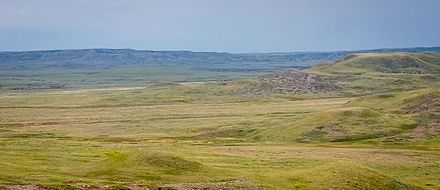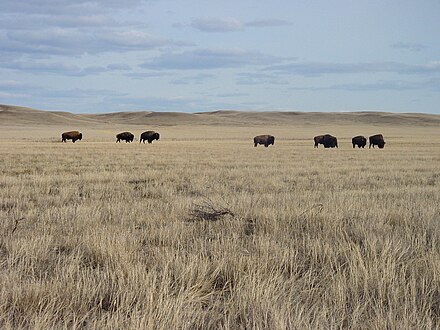Grasslands National Park - Canadian national park located in Saskatchewan
Grasslands National Park is in southwestern region of Saskatchewan. The park consists of two widely separated regions, the West Block and the East Block. The park is 477 km².
Understand
 Grasslands National Park covers an area of 907 km² (350 sq mi) near the village of Val Marie, Saskatchewan. This national park is north from the American state of Montana and lies adjacent to the international boundary.
Grasslands National Park covers an area of 907 km² (350 sq mi) near the village of Val Marie, Saskatchewan. This national park is north from the American state of Montana and lies adjacent to the international boundary.
- Grasslands National Park Visitor Centre (West Block), 101 Centre St, Val Marie, 49.2458°, -107.7321°, +1-877-345-2257, grasslands.info@pc.gc.ca.
- McGowan's Visitor Centre (Grasslands National Park Visitor Centre - East Block), 49.071466°, -106.529633°, +1-306-476-2018, grasslands.info@pc.gc.ca.
History
In 1874, Sir George Mercer Dawson discovered western Canada's first dinosaur remains in the Killdeer Badlands during the International Boundary Survey. Later, in 1877, Sitting Bull took refuge in the area with around 5000 Sioux after the defeat of General Custer at the Battle of Little Bighorn.
The park was established in 1981. In 2006 71 bison were introduced to the park. Following the herd reduction in the fall of 2015, there are approximately 310 adult bison in the park.
Landscape
Grasslands National Park is situated on the northern tip of North America's mixed grass prairie.
Grasslands National Park represents the Prairie Grasslands natural region, protecting one of the nation's few remaining areas of undisturbed dry mixed-grass/shortgrass prairie grassland. The park is in the World Wildlife Fund-defined Northern short grasslands ecoregion, which spans much of southern Saskatchewan, southern Alberta, and the northern Great Plains states in the USA.
Erosion by glacial meltwater formed many of the park's characteristic features. Highlights of the park's geological landscape include the Frenchman River Valley, the Seventy Mile Butte, and the badlands of Rock Creek.
Flora and fauna
The unique landscape and harsh, semi-arid climate provide niches for several adapted plants and animals.
The park and surrounding area house the country's only black-tailed prairie dog colonies. Rare and endangered fauna found in the park include bison, pronghorns, greater sage-grouses, burrowing owls, brown bears, coyotes, ferruginous hawks, swift foxes, elk, wolverines, prairie rattlesnakes, black-footed ferrets and greater short-horned lizards.
In 2006, Plains bison from Elk Island National Park in Alberta were reintroduced to Grasslands. By 2015 the herd had grown from the original 71 animals to over 300. The herd is maintained on a 181-km² section in the park's West Block.
In 2009, a small population of black-footed ferrets was reintroduced into the prairie dog towns after a 70-year absence. Improved night-lighting practices under the dark-sky agreement ensure that the park remains dark at night, preserving a natural environment for all nocturnal wildlife.
Flora includes blue grama grass, needlegrass, plains cottonwood and silver sagebrush.
Climate
It has a semi-arid climate. It can be a harsh climate, cold and windswept in the winter and often very dry for prolonged periods, broken sometimes by extremely intense rainfalls during the summer. Nearby Val Marie is sometimes the national hotspot in Canada on a given summer day. Val Marie gets more days of sunlight per year than anywhere else in Canada.
Get in
The West Block is about 350 km from Regina, and has access points off Highways #4 and #18 near Val Marie. The West Block of the park is located one hour south of Swift Current, and the main visitor reception centre is in the town of Val Marie. It is less than 30 km from the Morgan-Monchy Border Crossing from Montana, USA, itself about 90 km north of Malta, which has a train station on the Empire Builder Amtrak train.
The East Block is about 280 km from Regina, and has access points off Highway #18 – one south of Wood Mountain and the other east of Glentworth. Watch for signage. The East Block of the park is about an hour's drive south of Assiniboia near Wood Mountain Regional Park. The interpretive centre is in the McGowan House at the new Rock Creek Campground. The East Block is less than 20 km from the Opheim–West Poplar River Border Crossing from Montana, USA, itself about 100 km north of Glasgow, which has a train station on the Empire Builder Amtrak train.
The East Block is more of a wilderness area but has views of the badlands of Rock Creek, the Cretaceous–Paleogene boundary and prairie skies.
Fees and permits
There are no fees to enter the park.
Get around
See
Highlights of the West Block include the Frenchman River Valley, a herd of over 300 Plains bison as well as prairie dog colonies.
Do
Buy
Eat
Drink
Sleep
Lodging
Lodging is located outside the park in Val Marie.
Camping
There are campsites, Tipis and furnished tents on platforms available in the park.
In the West Block, the Frenchman Valley Campground offers visitors serviced camping sites, teepee camping and a cook shelter. Camping fees for overnight and can be paid at the Visitors Centre in Val Marie. Per night fees for 2018 are:
- Front country, serviced with electricity: $29.40
- Equestrian camping: $21.50
- Overflow camping: $15.70
- Backcountry use and camping, per person: $9.80
Other accommodation fees (2018):
- Per Tipi, per night:$45.00
- Equipment Rental for Tipi Camping (optional): $10.00
- oTENTik glamping, per night: $100.00 (a spacious blend of a tent and an A-frame cabin equipped with beds and furniture on a raised floor)
- Group camping - one night, per person, unserviced:$ 4.90
Backcountry
Backcountry camping is permitted. Enquire at the Visitors' Centre.
Stay safe
In July 2017, tests revealed that prairie dogs in the area have the sylvatic plague. Please exercise caution when near prairie dog colonies, there are potential health risks. Since 2010, all prairie dog colonies in the park have been closed to domestic animals to prevent the possibility of pets carrying infected fleas back to their owners.
